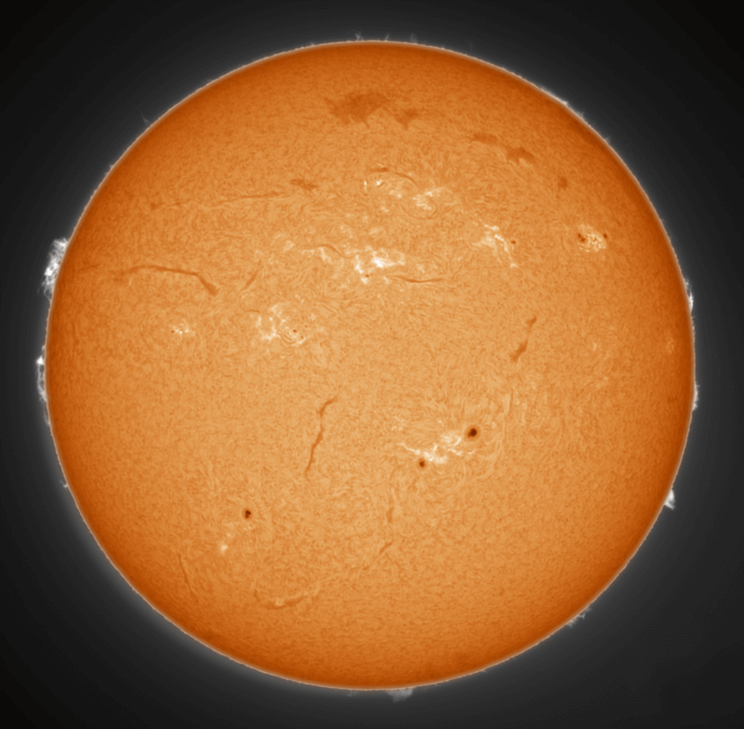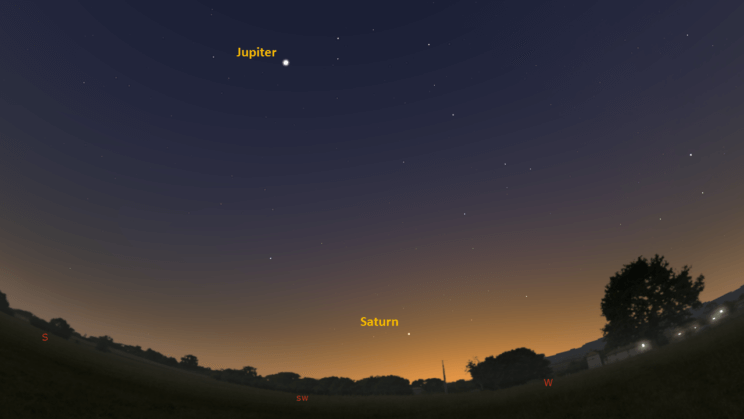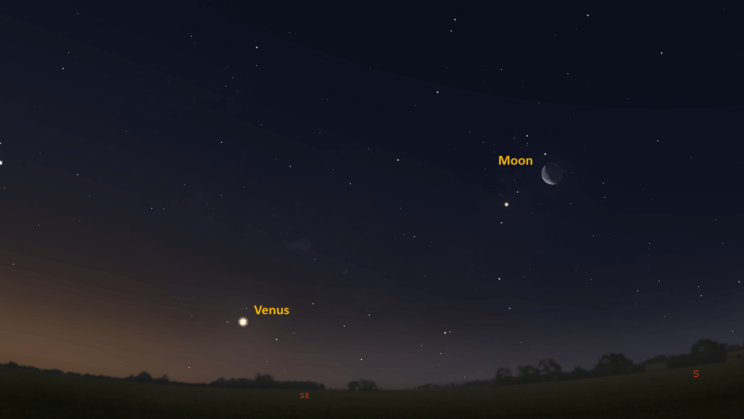This is the Saint Louis Science Center’s NIGHT SKY UPDATE for the week of Saturday, February 3, 2024.
Information updated weekly or as needed.
Times given as local St. Louis time which is Central Standard Time (CST). For definitions of terminology used in the night sky update, click the highlighted text. If relying on times posted in Universal Time (UT), St. louis is -6 hours when CST.
Observing Highlight of the Week

The Sun seen in H-alpha on December 23, 2023. Image credit: Kevin M. Gill
In about two months, most of North America will be treated to another solar eclipse on April 8, 2024. As we approach this date, the observing highlight each week will focus on various topics related to viewing this eclipse. We will include a few topics in February and then focus on the eclipse throughout the month of March. This week I would like to explore how to safely view the Sun.
On average the Sun is roughly 93 million miles away and it is approximately 109 times larger than Earth. Being so large and close, the Sun is one of the most detailed and dynamic objects we can observe provided you do so safely. When we talk to people about observing the Sun, they often are surprised by the topic as we are normally taught as children you should never look at the Sun. While this is good advice, we should clarify the idea by saying we should never look directly at the Sun. Doing so can lead to a disease called solar retinopathy which can cause permanent vision loss.
Proper safe methods of observing the Sun involve using safe solar filters or various projection methods. Which of these is best depends on who is observing. Very young children and the elderly are more susceptible to eye damage so I might recommend using projection methods if you are observing the eclipse with either of those groups. To project a view of the eclipse, all you need is something with a whole in it. The simplest projection method is done with a pinhole projector. Take an index card and poke a small hole in it which allows sunlight to stream through projecting an image of the Sun. If you find the image projected is not in focus, move the hole closer to or further from the surface you are projecting the light on. Adding a shadow box to this setup will make it even better. The image projected will not be large or detailed, but it will be good enough to observe the eclipse as it occurs. You find instructions for a pinhole camera here.
Optical instruments such as a telescope or binoculars can be used to project an image as well, but this adds an element of danger. Projection methods are indirect. You are not looking at the Sun but rather a projection of it. Adding optics to the projection system magnifies the light before it is projected. If someone accidentally looks through the unfiltered optics instead of looking at the projected image, they will damage their eyes. Managing this kind of setup in a crowd can be difficult due to this added danger. The benefit of using optics to project and image is the view will be focused, it will be larger, and it can reveal details such as sunspots. Only try this if you are comfortable with the setup and the people you will observe with. You can learn more about solar projection here.
The other safe option for observing the Sun is to use proper solar filters. Proper solar filters are designed and tested to meet the current standards for safe solar viewing as defined by the International Organization for Standardization (ISO). This group is comprised of the national standards bodies of 167 countries. Their current standard for safe solar viewing is ISO 12312-2:2015. If you plan to purchase solar filters for the eclipse in April, make sure they meet this standard.
There are a multitude of different filters available for solar viewing. The most common is called a white light or continuum filter. These are designed to transmit a safe amount of the visible spectrum through to your retinas while also filtering UV and IR radiation. This type of filter is what is used in eclipse glasses. Eclipse glasses are very inexpensive and are still readily available. They are what I recommend most people use to view the eclipse in April. It is important to ensure that the glasses you buy are ISO certified and are in good condition free of any damage. The American Astronomical Society has compiled a list of suppliers of safe solar viewers and filters which can be found here.
Continuum filters can also be used to create full aperture filters for cameras, binoculars and telescopes. While still inexpensive, large aperture filters can become expensive. If you have these devices at home, you might consider one of these filters. I checked many of the suppliers for these filters and most still have them in stock. As we approach April 8, 2024, it will be difficult to find these filters so get them while you can.
There are also narrow band solar filters. These are filters that target specific wavelengths of light. The most common is an H-alpha filter. This filter allows a safe amount of hydrogen alpha light through to your eye. This light comes from excited hydrogen atoms in the Sun’s inner atmosphere. H-alpha filters allow you to see several solar features such as sunspots, prominence and solar granulation. They provide amazing views of the Sun; however, their downside is their cost. They are very expensive. The telescopes that use them are generally only for the Sun. They are dedicated solar instruments. They are a great option for solar enthusiasts, but if your interest is only for the eclipse, you are better off using eclipse glasses or continuum filters on a normal telescope. H-alpha telescopes are available from Daystar Filters, Lunt and Coronado.
If done safely, the Sun is an amazing target to study. It is likely that interest in safe solar viewing will increase as we approach the next solar eclipse on April 8, 2024. If you live in the St. Louis area or are traveling through, the McDonnell Planetarium will again host our solar observing event called Solar Sundays starting March 10, 2024, through April 7, 2024. This event is dependent on the weather but if it is clear, each Sunday leading up to the eclipse, planetarium staff and volunteers from the local astronomy clubs will be on hand to safely show you the Sun.
The Sun and Moon

The Moon as seen from the International Space Station, on July 31, 2011.
Credit: NASA
Sun
Sunrise is at 7:05 a.m. on Saturday, February 3 and sunset is at 5:25 p.m. providing us with a roughly 10.5 hours of daylight this week. Even after sunset, light from the Sun will dimly illuminate our sky for about 1 hour and 30 minutes. This period is called twilight, which ends around 6:56 p.m. this week. For those with a sundial, local noon occurs around 12:14 p.m. this week.
| Day | Sunrise | Sunset | ||||||||||
|---|---|---|---|---|---|---|---|---|---|---|---|---|
| 3-Feb | 7:05 a.m. | 5:25 p.m. | ||||||||||
| 4-Feb | 7:04 a.m. | 5:26 p.m. | ||||||||||
| 5-Feb | 7:03 a.m. | 5:27 p.m. | ||||||||||
| 6-Feb | 7:02 a.m. | 5:28 p.m. | ||||||||||
| 7-Feb | 7:01 a.m. | 5:29 p.m. | ||||||||||
| 8-Feb | 7:00 a.m. | 5:30 p.m. | ||||||||||
| 9-Feb | 6:59 a.m. | 5:31 p.m. | ||||||||||
| 10-Feb | 6:58 a.m. | 5:33 p.m. | ||||||||||
| 11-Feb | 6:57 a.m. | 5:34 p.m. |
Moon
Moonrise for Saturday, February 3 was at 1:13 a.m. and moonset occurred at 11:13 a.m. On Saturday, February 3, the Moon will exhibit a waning crescent phase with roughly 40% disk illumination. By the end of the week the Moon will exhibit a waxing crescent phase with 6% disk illumination. New moon occurs on February 9, 2024, at 4:59 p.m.
International Space Station (ISS) Observing

There are two visible passes of ISS from St. Louis for the week of February 3. They occur during evening hours. The table below lists the passes that will be seen from St. Louis. If you do not live in the area, you can use https://heavens-above.com/ to set your viewing location and get times for where you are.
Catch ISS from St. Louis starting Saturday, February 3, 2024
| Date | Starts | Max. altitude | Ends | |||||||
|---|---|---|---|---|---|---|---|---|---|---|
| Time | Alt. | Az. | Time | Alt. | Az. | Time | Alt. | Az. | ||
| 03 Feb | -3 | 18:08:13 | 10 | WNW | 18:11:31 | 55 | SW | 18:14:48 | 10 | SE |
| 05 Feb | -0.7 | 18:09:53 | 10 | W | 18:12:11 | 17 | SW | 18:14:30 | 10 | S |
Magnitude (Mag): The Measure of brightness for a celestial object. The lower the value is, the brighter the object will be.
Altitude (Alt): The angle of a celestial object measured upwards from the observer’s horizon.
Azimuth (Az): The direction of a celestial object, measured clockwise from an observer’s location with north being 0°, east being 90°, south being 180° and west being 270°.
Detailed information regarding all unmanned exploration of our universe, missions past, present, and planned, can be found at Jet Propulsion Laboratories:
The Visible Planets

Looking southwest at 6:00 p.m. on February 3, 2024. Credit: Stellarium, EG

Looking southeast at 6:15 a.m. on February 4, 2024. Credit: Stellarium, EG
This week, three naked eye planets will be visible. Saturn and Jupiter are visible in the south once it is dark. Venus will be easy to find in the southeast before sunrise.
Venus
Venus rises this week around 5:24 a.m. It will be easy to spot for most by 6:15 a.m. Now that Venus is past dichotomy, it is headed back towards the Sun from our perspective. As this continues, Venus’s disk illumination will increase as it heads towards superior conjunction on June 4, 2024.
Jupiter
Jupiter has passed opposition and as such it will rise before the Sun sets. Jupiter will be easy to spot high in the south once it is dark outside. Jupiter will set around 12:09 a.m.
Saturn
Start looking for Saturn in the southwest about 30 minutes after sunset. Saturn will set around 7:07 p.m. Our window to see Saturn is starting to close as the planet approaches solar conjunction on February 28, 2024. As we approach this date Saturn will be found lower to the horizon each day eventually being lost to the Sun’s glare near the end of February.
James S. McDonnell Planetarium
Night Sky Update: February 3-11, 2024






